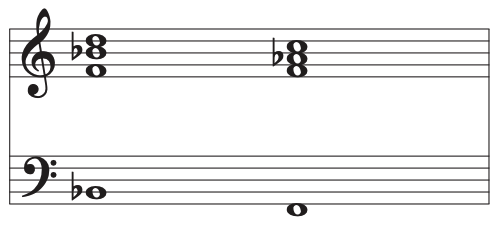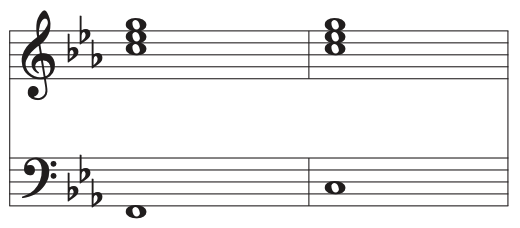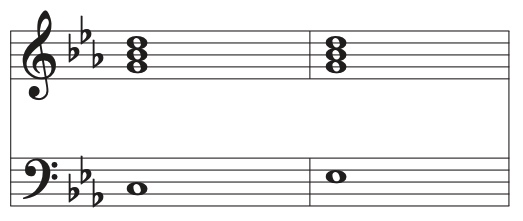Guest post by Ben Morss. This article originally appeared on Soundfly’s Flypaper.
For complete audio links please visit there.
Abel Tesfaye, also known as The Weeknd, and Ludwig van Beethoven don’t appear to have much in common. Ok, they’re both musicians, there are the repeated digits in their birth years (1990, 1770), they share perhaps a similar amount of curly hair… But, otherwise, come on, right?
And yet, although classical music of Beethoven’s era and pop circa 2020 are different beasts, music that works is music that works. Sometimes it just works because it’s performed or produced effectively. But often I submit that better music is better because the notes are better — the pitches and durations and the relationships and patterns these form, however they’re performed.
Good music works because there’s magic happening behind the scenes. If an eight-year-old plays Beethoven’s Für Elise on a slide whistle, it’s still Für Elise.
So with The Weeknd’s massive Super Bowl 2021 performance coming up, we wanted to take a closer look at his 2020 hit song “Blinding Lights,” a collaboration with the Swedish producer and hitmaker Max Martin.
In this article, we’ll see how Tesfaye and Martin built the song from simple building blocks, most notably a four-note pattern. Similarly, Beethoven based the famous first movement of his Fifth Symphony on a four-note pattern. You may have heard it: G G G E♭.

This four-note pattern is repeated and modified throughout Beethoven’s piece. This rigorous approach helps create one of the most tight, dramatic pieces of music in the Western world.
Sadly though, when the piece premiered in 1808, the Billboard charts didn’t exist yet. And so it wouldn’t hit #1 on the Hot 100 until 1976, when Walter Murphy thankfully wrote and recorded a disco version.
You might not expect to find such rigorous construction in pop music, a realm in which many songwriters and performers don’t themselves read music. But a lot of the best work in music occurs intuitively, and one can often find patterns and construction techniques in pop songs that clearly help the songs excel, but which the song’s creators were never consciously aware of.
We can be pretty sure, though, that the writers of “Blinding Lights” worked on it and refined it for quite a while. After all, Max Martin is known for his rigorous and demanding approach to crafting a melody.
Melodic Math
In interviews, Martin refers to his “melodic math.” He told Time: “We’ll spend days, sometimes weeks, challenging the melody. The goal is to make it sound like anyone can do this, but it’s actually very difficult.” He also said, “I want to be part of every note, every single moment going on in the studio. I want nothing forgotten, I want nothing missed. I’m a perfectionist.”

Martin also has formal training. I don’t know whether Tesfaye has as much formal musical background. But we do know that he’s a workaholic who cares about the notes, the substance behind the production.
A manager of Tesfaye’s says: “He has a work ethic like I’ve never seen before…. We call him ‘The Machine’ because he’s always working.” And Tesfaye once told Rolling Stone: “It’s all about songs for me right now. The production can be cool and crazy-sounding, but that’s just special effects. If you can’t strip it down and play it on piano, it’s not a good song.”
Tesfaye is the kind of guy who used to do crossword puzzles to improve his vocabulary. It’s not hard to imagine Tesfaye and Martin in the studio dissecting their melody, considering every note, constructing a crossword puzzle of their very own. So, let’s look at “Blinding Lights” in detail and see how the two created a crossword puzzle of melody and simple musical gestures.
And if any of the theory below goes a bit over your head, feel free to brush up on your knowledge of harmony with Soundfly’s online course, Unlocking the Emotional Power of Chords.
The Building Blocks of “Blinding Lights”
The song is a single-progression song. After a short introduction which prolongs an F minor chord, the song repeats four chords over and over without deviation: Fm Cm E♭ B♭.
We’ll see how Tesfaye and Martin are able to create variety and even cadences without ever changing the chord progression. How? The tones in the song’s sections bring out new relationships between the chords, often making them sound like the chords themselves have changed even though they haven’t.
They use simple materials to make the song easy to grasp, to eliminate barriers between song and listener. The song’s melodic material is entirely derived from the F Dorian scale: F G A♭ B♭ C D E♭ F.

Within this, though, the F pentatonic scale is strongly emphasized: F G B♭ C E♭ F.

Pentatonic scales are quite common in pop music. They occur in folk songs from many cultures, and they’ve been common in American popular song since at least the 19th century. “Oh! Susanna” is one of many songs to use the major pentatonic scale: F G A C D F.

The minor pentatonic scale is also popular, most likely because it relates closely to the blues scale. The F minor pentatonic scale is: F A♭ B♭ C E♭ F.

The pentatonic scale in “Blinding Lights” is similar to this minor pentatonic. The only difference is the second note, which is G instead of A♭. As we’ll see, the G is useful because it fits so well over the Cm and E♭ chords, and because it produces a nice crunchy ninth over the F minor chord.
Neither the song’s chords nor its scales are unusual. What’s more surprising is that each section of the song is based on either one or two four-note scale segments. Typically these segments are drawn from the pentatonic scale, but in two notable cases, they’re from the Dorian scale.
For example, here’s the song’s opening riff.

The first four measures are built from the scale segment (C E♭ F G), and the last four measures are built from the segment (E♭ F G B♭).
This level of rigor isn’t actually that unusual for songs where Max Martin is involved. Just a bit like Beethoven did in his Fifth Symphony, Martin loves to deploy the same melodic bits again and again. He particularly likes to use the same motif over different chords, adding variety even while repeating a hook.
For example, listen to the start of the verse from Taylor Swift’s “Shake It Off” (which Martin collaborated on writing).
Here’s what that looks like written out:

This song kind of drives me crazy, making me pine for earlier Swift songs like “Love Story” — but it’s extremely methodical and catchy, and it was a #1 hit in the U.S. It’s worth noting that the motif in “Shake It Off” is: G A B D, the exact same pitches as the scale segment we just saw in “Blinding Lights” (E♭ F G B♭). The only difference is that “Shake It Off” is based on the major pentatonic scale.
Now let’s look at each section of the song. We’ll see how Tesfaye and Martin deploy simple, consistent materials to build a logical, thrilling song structure. For easy reference, I’ve summarized most of what we’ll discuss in this table:

If you go to a piano and play the chord roots with your left hand while playing the notes from any table cell in your right hand, it will sound kind of like that section of the song. If your right hand just noodles around with the pentatonic scale or the scale segments, it will sound like the song, too. Try it!
The Opening Riff
As stated above, the opening keyboard riff divides neatly into two parts. Each part is built on a four-note scale segment:
This riff introduces us to the world of the song in a few ways. First, it previews the chorus. Like the chorus, its first four measures are based on the scale segment (C E♭ F G), and its last four measures are based on the segment (E♭ F G B).
In fact, the last four measures of the riff and the chorus are identical.
The riff also introduces us to the song’s melodic and harmonic materials. It contains all five notes of the pentatonic scale we described above (and no others). It uses the two scale segments from which three of the song’s five sections are drawn. And, like every section of the song save one, it contains five pitches.
Finally, of course, this is when we first hear the song’s chord progression.
The Verse
Tesfaye and Martin deploy the same materials to make the verse the section of the song with the lowest energy. The melody repeatedly moves down. And the same chords we heard in the verse are here repurposed to sound ambiguous and static.
The verse melody begins by moving from low C to B♭ and back to C, then stopping. Next, it uses another four-note scale segment (G B♭ C D) to descend even further. It repeats that slide down with another (G B♭ C D), then we hear an even lower four-note scale segment (F G B♭ C), sliding down to the lowest point in the song.

I won’t go into details here now (though someday I’ll write about ways to apply Schenkenerian analysis to pop music), but I’d argue that the verse prolongs the note C, starting off with a long C, then dipping down from there to G and F while maintaining the feeling of C throughout. This pitch marks a low point in the song.
Underlying the verse melody is this repeating keyboard pattern: C E♭ C E♭ F G E♭ F.

By now, you’ll probably recognize this as another manifestation of the scale segment used in the opening riff (C E♭ F G). This time, though, the pitches are used throughout the chord progression.
In fact, these are the only notes in the track aside from the bass. Nothing else is there to define the chords more strongly. The result is that the chord changes are smoothed out. Without the melody, the track sounds like a single chord with changes in the bass.
A look at the table above reveals that the verse is the only section where the scale segments include the note D. As we progress to the Climb section, we’ll discover that D is a special note in this song. In the verse, it’s used to express dissonance, to carve out a tonal area that’s unique. The D is a ninth over the C and a major seventh over the E♭. It keeps resolving down to C.
Each resolution feels sad, and the energy sags.

The D resolves down, but it also points up to the melodic E♭ in the next section.
+ Read more on Flypaper: “Chorus Impact Accentuators, Explained.”
The Climb
After the verse comes a section where the energy increases to drive to the chorus. Sometimes this is called the pre-chorus or the climb. I like the term “climb” in this case, because you can literally feel the tune climbing up toward the chorus.
Sure enough, while the verse kept moving down, the climb features a rising melodic phrase that’s repeated three times. It uses a new scale segment (C E♭ F G).

We ended the verse with the scale segment (F G B♭ C) over a B♭ chord. The new pattern, (C E♭ F G), is simply the old pattern transposed up a fifth, matching the Fm chord over which it appears. We now hear this pattern over three different chords, just like Martin did in “Shake It Off.” Each time we hear it, the new chord highlights different features of the motif.
- When heard over the Fm chord, the pattern doesn’t contain a third, but it does feature a strong move toward F itself: C E♭ F.
- Over the Cm chord, the pattern starts to outline a C minor triad clearly: C E♭ F G. But then it resolves down to F, an ambiguous fourth scale degree.
- Over the E♭ chord, the pattern doesn’t strengthen the tonality much at all.
The melody is still anchored on the same C as the verse. The difference is that the verse kept dipping down from the C to a low G or F, whereas the climb keeps reaching up toward a high G before resolving down to F. This anchoring on C is strengthened by the backing vocal, which keeps briefly inserting a C before descending to B♭.

So, the motif repeats three times.
Then, there’s a striking moment: the tune moves to a new note (D). The backing track cuts out, and we hear a halting, staccato pattern that appears nowhere else in the song, bringing us down the scale to the B♭ just heard in the backing vocals (D C B♭).

What’s going on here?
Clearly this moment was created to highlight the chorus. It’s an interesting approach. We’ve been climbing up toward the chorus, and suddenly all the motion stops. The rhythm turns staccato and stilted, the beat goes away, the tune descends slowly down – and there’s this new note.
The effect is that we move to the chorus not just through a build or through contrast, but through both. The song builds, and then the energy drops to zero, right before the high-energy chorus. Remember how we said the note D is used in this song in a special way?
Here, notice that the climb pattern (C E♭ F G) skips the D. And it skips it three times in a row. This builds an expectation that we will eventually hear the D, so when it does come in, it’s infused with special meaning. And because we stop on the note D, the note also functions as a cadence. Specifically, it’s a IV-i cadence, also called a plagal cadence:

In classical music, composers like Beethoven created a big arrival through a V-I cadence, like this:
Now, V-I progressions are still very common in pop music. And plenty of songs, especially older pop songs, approach the chorus with a V-I progression. When such songs land on the I at the start of the chorus, it’s a powerful arrival that screams, “Hey! Chorus!”
So why doesn’t “Blinding Lights” hit the chorus with a V-I arrival?
First of all, the song’s chord progression doesn’t contain any V-I progressions. Adding one would mean changing those chords. This would break the rules the song’s set out for itself, so the V chord would stick out — and nothing sounds as fake as a forced V-I cadence.
It’s actually characteristic of pop music to replace V-I movements with IV-I, in ways that would never occur in classical music but which “sound like” modern pop. It’s simply more subtle, more “cool,” less overt. It’s also more characteristic of the blues, which remains a strong influence on pop, even today.
In fact, thinking about The Weeknd’s hits, I don’t think there’s a V-I movement among them. The chord progression of “I Feel It Coming,” a collaboration with Daft Punk, features an especially beautiful IV-I, though.
Back to “Blinding Lights.” After this cadence concludes, Tesfaye suddenly leaps up to the highest note in the song, a high C, leading into the chorus with: C E♭ F. This is the same pattern that began the climb, except that the C is an octave up — and instead of moving up to G and resolving down to F, he skips the G and goes straight to the F. Holding this F, he starts the chorus.
The Chorus
The chorus features the same chord progression and a similar arrangement as the rest of the song. So, how does it establish itself as a chorus, the song’s main hook?
First, the melody makes a classic chorus move: it begins with a long held note (F). This moment is unique in the song; it’s the only time that Tesfaye really holds a long note. The tune then gently descends to C over the course of four measures, the longest phrase in the song.
The chorus is traditionally (though not always) higher than the preceding sections. That’s certainly the case here. The tune prolongs an F, beginning and ending on this pitch. And it hits a high of B♭, well above the peaks in the verse (D) or climb (G).
But there’s more. Tesfaye and Martin do something more subtle, but equally important, to heighten the sense that the chorus is a place of arrival, of stability. We’ve noted that the verse melody destabilizes feelings of strong chords, and the climb is a little more clearly tonal but not much. In contrast, the chorus strongly establishes all four chords in the progression.

First, the tune anchors strongly in F Dorian, the key of the song, with the long F in the melody. Then we descend gracefully to C via G and E♭, forming a full C minor triad. Next, over the E♭ chord, the melody includes: B♭, G, and E♭ — an E♭ major triad.
Finally, on the B♭ chord, the melody stops on F, the fifth of the chord, omitting only D, which, as we keep saying, is reserved in this song for special occasions.
As a corollary of these strong chord harmonizations, the melody forms consonant, powerful melodic intervals over the bass. For every chord, there’s a strong fifth or octave:

These strong intervals tend to produce a tune that’s particularly anthemic — dare we say, chorus-like? They’re also highly characteristic of Beatles songs. Did I mention that Max Martin is third on the list of songwriters with the most #1 hits in the U.S. And can you guess who’s at #1 and #2?
Oh, and by now, you may have noticed that the chorus uses the exact same scale segments as the opening riff: (C E♭ F G) for the first phrase, and for the second (E♭ F G B♭).
The Bridge
By the time they get to the bridge, Tesfaye and Martin have already constructed four distinct, contrasting sections out of their sparse materials. Is there anywhere left to go? Let’s find out.
Traditionally the bridge contains the highest notes in the song. The chorus already featured two high B♭’s, which are an octave and a fourth above the low F of the verse. Fortunately, Tesfaye’s falsetto can go even higher, and in the bridge he outdoes himself with three high C’s.
Not only does the bridge feature our highest notes, but I’d argue that it prolongs high notes throughout. The bridge melody repeatedly reaches up from F to move from a high B♭ to high C, then back to B♭. This is well above the F of the chorus and the low C of the verse. Here’s a visual summary of that:

Traditionally the bridge travels to new harmonic areas. In a single-progression song, we can’t move to a new key. But once again the melody makes the chords feel like they’ve changed. Prolonging the strong high C over the Fm, Cm, and E♭ chords brings out a new flavor in each.
(If you sing the notes prolonged by the other sections over the chords, and then sing a high C over the chords, you’ll see what I mean.)
And then, at the end, the tune does something new to create yet another cadence – it adds the notes — B♭ A♭ G F — over the B♭ chord. We’ve never heard this scale segment in the song. We’ve never even heard four notes in a row that were from the Dorian scale, not the pentatonic scale. And it’s the only A♭ in the tune.
The effect is of a dramatic B♭7 chord, which then leads, through yet another plagal cadence, into the final chorus.
The bridge melody descends dramatically through large intervals from high C, three times in a row. Through all these devices, Tesfaye and Martin make the bridge the most intense section of the song. And then, we return to the chorus. Next the song brings back the opening riff.
Finally, we get to hear the chorus sung over the riff, we realize how similar they are, and the song ends. The crowd goes wild.
But Wait, There’s More…
Before we go, here are a few other interesting features of “Blinding Lights.”
1. Looking at the table at the start of this article, you’ll notice that four of the five sections contain exactly five pitches. In three cases — the riff, verse, and chorus — that occurs because the section contains two segments that overlap by three notes, like (C E♭ F G) and (E♭ F G B♭).
2. Did I mention that the roots of the song’s four chords, taken together, form yet another four-note segment (B♭ C E♭ F) of our pentatonic scale?
3. Remember how Max Martin and Taylor Swift explored how the same pitches sounded over different chords in “Shake It Off?” Let’s briefly look at the same phenomenon in “Blinding Lights.”
Here are the notes in the first two bars of the opening riff, verticalized into chords:

Notice that the riff forms a ninth chord over the Fm chord. When it’s repeated over the Cm chord, it’s a consonant triad. By simply repeating the same notes, Tesfaye and Martin create a dissonance and its resolution.
Now here are the notes in the second and third bars of the verse:

The verse is supposed to be less harmonically stable. Notice that when the scale segment enters, it’s the riff’s scale segment transposed up a fifth, over a chord that’s up a fifth. So it expresses the same ninth chord. In the verse, though, this pattern starts one chord later.
So, now, when the scale segment repeats, it’s over an E♭ chord, where it forms a dissonant major seventh chord. Instead of resolving, the dissonance remains. I’ll leave it to you, dear reader, to follow this through the rest of the song, because I need to go out and shovel snow!
This song sounds so smooth in part because Tesfaye and Martin use simple materials consistently to build different song sections, sections they deploy to create a song that flows logically from start to finish. They achieve variety in a few ways:
- Changing the scale segment
- Changing note durations and rhythms
- Changing the direction of the melody
- Changing how strongly the chords are defined
- Changing the highest note of each section
- Changing the pitch each section prolongs
- Building an occasional IV-i cadence
By doing so much with the pitches, they don’t feel a need to vary the song textures, arrangement, or chord progression — or use a single pitch from outside the F Dorian scale. Tesfaye doesn’t even feel a need to create lyrics that stand out or mean much of anything.
And so we see that diverse structures can be built from simple materials. The most sublime complexity emerges from simplicity. Beethoven showed this to us back in 1808. Abel Tesfaye and Max Martin showed us this in 2020. In music, this technique can support emotional expression that feels honest, succinct, real. Other people have pointed out that simple materials just might have the power to generate the universe.
Ben Morss earned a BA in Computer Science from Harvard and a PhD in Music at UC Davis, which he immediately squandered by playing with bands like Cake, Wheatus, and Onward Chariots. An alumnus of the BMI Musical Theater Workshop, Ben co-wrote two musicals based on Angelina Ballerina, and he’s currently working on a musical/opera that’s not really about Steve Jobs.
